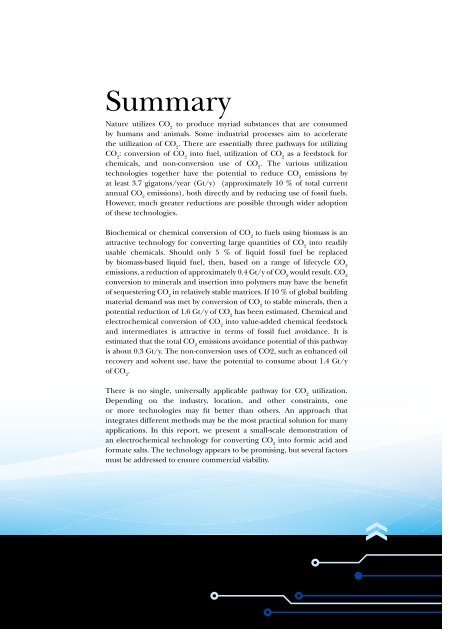Carbon Dioxide Utilization - DNV
Carbon Dioxide Utilization - DNV
Carbon Dioxide Utilization - DNV
You also want an ePaper? Increase the reach of your titles
YUMPU automatically turns print PDFs into web optimized ePapers that Google loves.
SummaryNature utilizes CO 2to produce myriad substances that are consumedby humans and animals. Some industrial processes aim to acceleratethe utilization of CO 2. There are essentially three pathways for utilizingCO 2: conversion of CO 2into fuel, utilization of CO 2as a feedstock forchemicals, and non-conversion use of CO 2. The various utilizationtechnologies together have the potential to reduce CO 2emissions byat least 3.7 gigatons/year (Gt/y) (approximately 10 % of total currentannual CO 2emissions), both directly and by reducing use of fossil fuels.However, much greater reductions are possible through wider adoptionof these technologies.Biochemical or chemical conversion of CO 2to fuels using biomass is anattractive technology for converting large quantities of CO 2into readilyusable chemicals. Should only 5 % of liquid fossil fuel be replacedby biomass-based liquid fuel, then, based on a range of lifecycle CO 2emissions, a reduction of approximately 0.4 Gt/y of CO 2would result. CO 2conversion to minerals and insertion into polymers may have the benefitof sequestering CO 2in relatively stable matrices. If 10 % of global buildingmaterial demand was met by conversion of CO 2to stable minerals, then apotential reduction of 1.6 Gt/y of CO 2has been estimated. Chemical andelectrochemical conversion of CO 2into value-added chemical feedstockand intermediates is attractive in terms of fossil fuel avoidance. It isestimated that the total CO 2emissions avoidance potential of this pathwayis about 0.3 Gt/y. The non-conversion uses of CO2, such as enhanced oilrecovery and solvent use, have the potential to consume about 1.4 Gt/yof CO 2.There is no single, universally applicable pathway for CO 2utilization.Depending on the industry, location, and other constraints, oneor more technologies may fit better than others. An approach thatintegrates different methods may be the most practical solution for manyapplications. In this report, we present a small-scale demonstration ofan electrochemical technology for converting CO 2into formic acid andformate salts. The technology appears to be promising, but several factorsmust be addressed to ensure commercial viability.





![Risk Based Pipeline Integrity Management [Compatibility Mode] - DNV](https://img.yumpu.com/50424229/1/190x146/risk-based-pipeline-integrity-management-compatibility-mode-dnv.jpg?quality=85)










